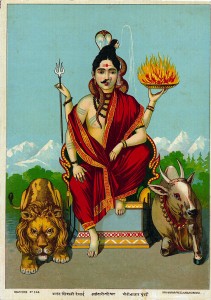
Ardhanarishvara – Saguna Brahman and Shakti
Sri Ramakrishna was an extraordinary exponent of the idea of harmony. All his actions, messages, etc were rooted in the idea of harmony. Through his extraordinary spiritual insights based on his own experiences he brought about a wonderful harmony between Brahman and Shakti. In the traditional Advaita Vedanta the idea of Shakti is never accepted. It is always unitary consciousness or atman or Brahman which is the one and only reality. Everything else is classified under the idea of maya or illusion. Although at the highest level of spiritual experience this idea is experienced, people in the initial stages of spiritual life strive hard to harmonize this idea of unitary consciousness with the existential world. If it is accepted that everything else is maya or illusion and Brahman alone is real, all that a sadhaka or a spiritual aspirant is engaged with, come under the classification of illusion which in effect means unreal. But, Sri Ramakrishna through his concept of Shakti gave a new meaning to the interpretation of Shakti in this existential world.
He said that Brahman and Shakti are the two aspects of the same reality like the obverse and reverse of the same coin. He would say that Brahman is nishkriya or actionless like the coiled up state of Kundalini. This he would compare to a serpent lying coiled up and dormant. He would compare Shakti to the awakened or active kunkalini like a serpent which glides and moves about. He would also use several other examples.He would say that Brahman and Shakti are like fire and its burning power or like the milk and its whiteness or like water and its capacity to wet.
Thus he would say that while Brahman or unitary consciousness is the supreme reality, what we perceive as the manifested world is just the power of Shakti which once again is the other aspect of Brahman namely the creative aspect. Thus he would give a meaningful world view.
-by Swami Shantatmananda, Sunday Guardian,16th Aug 2014
(Photo courtesy: http://blog.visionaire.org/2011/12/calendario-hindu-2012/)
